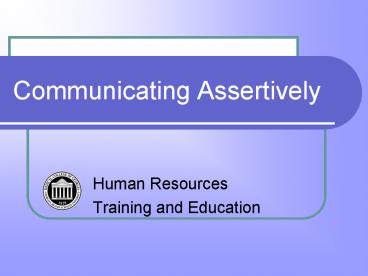Communicating Assertively - PowerPoint PPT Presentation
1 / 55
Title:
Communicating Assertively
Description:
To provide you with the skills to communicate more assertively. ... Assertiveness is the ability to honestly ... Verbal Styles: Apologetic and tentative voice ... – PowerPoint PPT presentation
Number of Views:304
Avg rating:3.0/5.0
Title: Communicating Assertively
1
Communicating Assertively
- Human Resources
- Training and Education
2
Purpose
- To provide you with the skills to communicate
more assertively. - To be able to tell others what you want, think,
and feel.
3
Objectives
- Define assertiveness.
- Understand the four communication styles.
- Examine techniques for assertiveness.
- Learn to speak with confidence.
4
What is Assertiveness?
- Assertiveness is the ability to honestly express
your opinions, feelings, attitudes, and rights,
without undue anxiety, in a way that doesn't
infringe on the rights of others. - It's not aggressiveness, it's a middle ground
between being a bully and a doormat.
5
Why is Assertiveness Important?
- If you don't know how to be assertive, you might
experience --- - Depression
- Resentment
- Temper/violence
- Anxiety, which leads to avoidance
- Poor relationships of all kinds
- Physical complaints
6
How Assertive Are You?
- Assertiveness self-assessment. Read the
statements in your workbook and decide how you
would most likely respond in each situation.
7
4 Styles of Communication
- Passive
- Aggressive
- Passive-Aggressive
- Assertive
8
Passive Style
- Definition You put the rights of others before
your own, minimizing your own self-worth. - Message this sends Your feelings are not
important, that you dont matter and that you
think you are inferior.
9
Passive Style
- Verbal Styles Apologetic and tentative voice
- Non-Verbal Styles Looking down or away stooped
posture, and excessive head nodding
10
Passive Style
- Behavior
- Hope others will give them what they want
- Are concerned about how others judge them
- Need to be liked
- Keep their personal opinions, feelings or desires
to themselves
11
Passive Style
- Potential consequences
- Lowered self-esteem
- Anger at self
- False feelings of inferiority
- Disrespect from others
- Pitied by others
12
Passive Style
- Statements made by a passive person
- Im sorry I guess it was my fault.
- No, I was wrong.
- I shouldve asked that question earlier.
13
Aggressive Style
- Definition You stand up for your rights, but
violate the rights of others. - Message this sends Your feelings are not
important you do not matter I think I am
superior
14
Aggressive Style
- Verbal Styles You statements loud voice
- Non-Verbal Styles Staring tense clenched
fists pointing fingers
15
Aggressive Style
- Behavior
- Violates other peoples space
- Demands what they need from others
- Are concerned only with their feelings
- Like to be feared
16
Aggressive Style
- Potential consequences
- Anger from others
- Lowered self-esteem
- Disrespect from others
- Feared by others
17
Aggressive Style
- Statements made by an aggressive person
- If you talk to me that way again, you can do the
job yourself. - You are too slow, I will just do the job
myself.
18
Passive-Aggressive Style
- Definition An individual who hides their
hostility or anger by being nice. - Message this sends Feelings don't count. It is
better to deny my feelings than upset another
person I am in disagreement with.
19
Passive-Aggressive Style
- Verbal Styles
- People take advantage of my giving nature.
- I do "too much" for others.
- Some people want to use me and care nothing about
me. - Non-Verbal Styles
- Smiling, then rolling eyes
20
Passive-Aggressive Style
- Behavior
- Sulks or argues when asked to do something he
doesn't want to do - Believes he is doing a much better job than
others think - Sometimes agrees to do things for others and then
doesnt follow through - Sometimes acts out annoying behavior while not
consciously knowing its impact on others.
21
Passive-Aggressive Style
- Potential consequences
- Others get upset and angry
- Resentment
- Lack of trust
- Confusion
22
Assertive Style
- Definition You stand up for your rights while
maintaining respect for the rights of others - Message this sends We are both important we
both matter I think we are equal
23
Assertive Style
- Verbal Styles I statements firm voice
- Non-Verbal Styles Looking direct relaxed
posture smooth movements
24
Assertive Style
- Behavior
- Direct eye contact
- Confidence
- Concerned about others feelings
25
Assertive Style
- Potential consequences
- Higher self-esteem
- Self-respect
- Respect from others
26
Assertive Style
- Statement made by an assertive person
- Actually I did turn the project in on time. Is
there a problem?
27
Communicating Directly
- The single most important key to getting what
you want is to ask directly.
28
What is the Style?
- Open your workbooks to page 12 and read the two
scenarios. - Develop a passive, aggressive, and assertive
response.
29
Becoming More Assertive
30
Is Assertiveness the Best Choice?
- Before you decide to act assertively in a given
situation, you have to decide if you can live
with the consequences. Although assertive
behavior usually will result in a positive
response, some people might react negatively to
it.
31
Selective Assertiveness
- Most people find it easier to be assertive in
some situations than in others. It's a lot easier
to hold your ground with a stranger than with
someone you love who might get angry if you
express your true feelings. - But the more important the relationship is to
you, the more important it is to be assertive.
32
How Can I Be More Assertive?
- Identify what you need and how you feel.
- "I would appreciate it if you would.....
- "I notice that..."
- 2. Express your needs and feelings to someone
else. - "When I see....I feel...."
33
I Statements
- Provide a means to express a feeling, thought, or
request. - Typically has three parts
I feel (emotion), when you (behavior), I would
prefer that you (alternate behavior).
34
Assertive Tip
- If you're planning to try assertive behavior,
remember that the other person is used to you
behaving in a certain way, and may be thrown for
a loop or thoroughly confused when you change
your communication style. - Why not tell the other person up front what
you're trying to do?
35
Learning to Be More Assertive
- Learn how to say No
- Learn how to ask for something
- Learn how to tell another person something
unpleasant - Learn how to share positive feelings
- Learn to listen assertively
- Learn to use non-verbal assertive body language
- Learn to speak up for yourself
- State what you want
36
Learn How to Say No
- Saying "yes" when you want to, and saying "no"
when you mean "no" - Deciding on, and sticking to, clear boundaries
being happy to defend your position, even if it
provokes conflict
37
How to Say No
- I'd rather not
- I can't do that right now
- I've promised myself to finish this (paper) right
now, so no - No thanks
- Not this time
- I'm afraid I have to decline
- Sorry, but no
- Thanks for asking, but no
- Nope, can't do it
38
Learn How to Ask for Something
- Use an "I" statement that contains the word
"need, "want" or its equivalent. - For example
- I need to be alone for a while.
- Please be quiet when the professor is speaking
because I can't hear her when you are talking. - I want to go home now.
- I need to talk to you.
39
Learn How to Share With Someone
- Feelings, such as feelings of anger or hurt, can
be difficult to share with someone. - I felt hurt and embarrassed that you did not
introduce me to your friend. - I felt left out when all of you went out for ice
cream and didn't invite me. - I feel annoyed and frustrated when you play your
stereo when I'm trying to study.
40
Learn How to Share Feelings
- Accepting a compliment or sharing other positive
feelings can be difficult. - For example
- I like you a lot.
- I enjoy your company.
- I really appreciated your help.
- Thank you! (when given a compliment)
41
Listen Assertively
- Let the other know that you want to understand
his or her point of view. - Understand accurately what another person is
saying. - Let the other person know that he or she has been
understood.
42
Listen Assertively
- I'd like to hear your views on....
- I'd like to understand your views on....
- I 'd like to hear your thoughts on ...
- I'm confused about your stand on....
- Would you tell me more about how you see the
situation? - What does the situation look like from your
perspective?
43
Nonverbal Assertiveness
- Direct eye contact
- Posture
- Facial expressions
- Gestures
- Personal appearance
- Tone of voice
44
Learn to Speak Up for Yourself
- Be clear about what you feel, what you need and
how it can be achieved - Be able to communicate calmly without attacking
another person - Express your opinions honestly
- Use facts, and be specific
- Make direct requests
- Be confident
45
State What You Want
- This is a specific request for a specific change
in the other persons behavior. - State your goal and outcome.
46
Assertiveness Road Blocks
- Pleaser behaviors
- Societal blocks
- Our upbringing conditions us to behave in certain
patterns
47
Assertive Scenarios
- In your workbook turn to page 13.
- Choose one scenario from each group and develop
an assertive response.
48
Tips for Acting Assertively
- The more important the relationship is to you,
the more important it is to be assertive.
49
Tip Acting Assertively
- Dont get personal. When expressing annoyance or
criticism, comment on the persons behavior
rather than attacking the person.
50
Tip Acting Assertively
- Use "I" statements. Keep the focus on the problem
you're having, not on accusing or blaming the
other person. - For example Say, "I'd like to be able to tell
my stories without interruption," instead of,
"You're always interrupting my stories!"
51
Tip Acting Assertively
- Use facts, not judgments.
- For example Say, "Your punctuation needs work
and your formatting is inconsistent," instead of,
"This is sloppy work."
52
Tip Acting Assertively
- Before you decide to act assertively in a given
situation, you have to decide if you can live
with the consequences.
- Assertive behaviors lead to increased respect
from others.
53
Tip Acting Assertively
- Pick your battles and assess the risk
- Is there a real safety risk?
- If I stand up to my boss, will I lose my job?
- Can I live with myself if I dont deal with the
problem?
54
Summary
- One of the most common problems in communications
is caused by trying to read people's minds or
expecting them to read yours. If you want people
to respond to your ideas and needs, you have to
be able to say what they are, and say it in a way
that will make others want to respond nicely.
55
Resources
- Alberti, Robert E., and Emmons, Michael. Your
Perfect Right. Revised edition. San Luis Obispo,
CA IMPACT, 1990. - Bower, Sharon, and Bower, Gordon. Asserting
Yourself. Reading, Massachusetts Addison-Wesley,
1976. - Bramson, Robert M. Coping with Difficult
People. New York Anchor/Doubleday, 1981 - http//mtstcil.org/skills/assert-3.html































